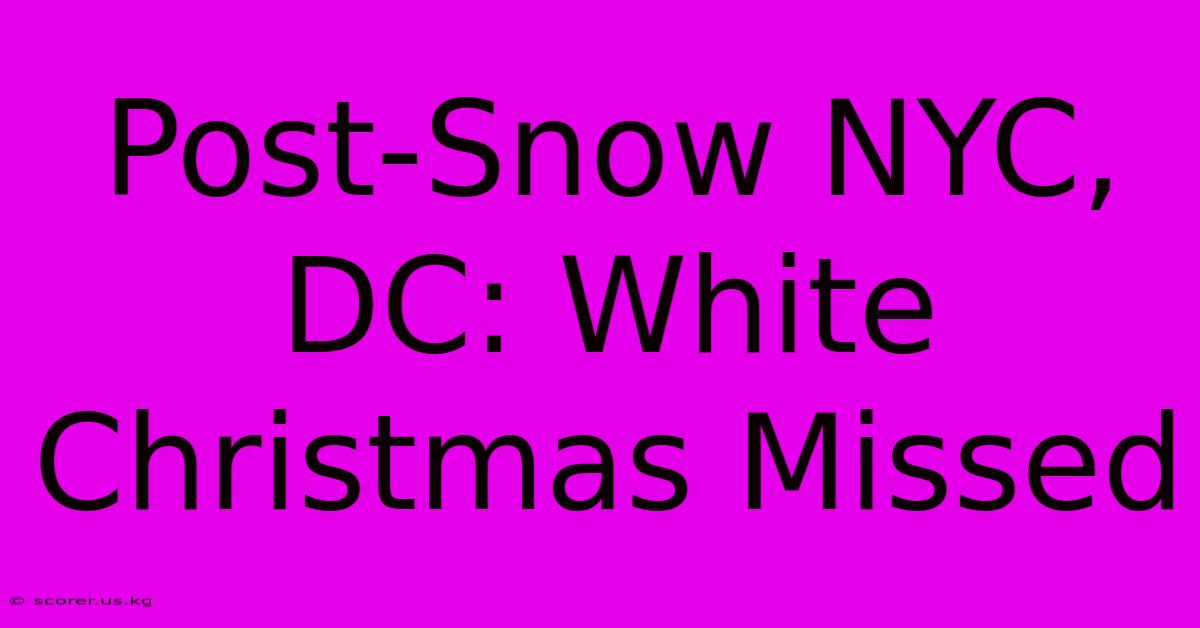Post-Snow NYC, DC: White Christmas Missed

Discover more detailed and exciting information on our website. Click the link below to start your adventure: Visit Best Website scorer.us.kg. Don't miss out!
Table of Contents
Post-Snow NYC, DC: White Christmas Missed – A Look at the Mild Winter
The Northeast missed out on a classic white Christmas this year, leaving New York City and Washington D.C. surprisingly green. While many romanticize a snowy holiday, the reality of a mild Christmas brought its own set of observations and impacts. This post explores the reasons behind the lack of snow, its implications for both cities, and what it means for the rest of the winter season.
A Green Christmas in the Big Apple and the Nation's Capital
Instead of a blanket of white, New Yorkers and Washingtonians woke up to relatively mild temperatures and clear skies on Christmas morning. This stark contrast to the imagery often associated with Christmas prompted a wave of social media posts, some humorous, some disappointed, all reflecting the unusual weather. The absence of a significant snowfall impacted various aspects of life, from holiday travel to outdoor activities.
Impacts of the Mild Weather
- Tourism: While snow can deter some tourists, the milder weather may have encouraged others to visit, impacting hotel occupancy and other tourism-related businesses.
- Retail: The lack of snow might have affected sales of winter clothing and snow-related items. Conversely, it could have boosted sales in other sectors, such as those related to outdoor activities that aren't snow-dependent.
- Transportation: The absence of snow and ice significantly eased transportation challenges, making travel smoother than in years with heavy snowfall.
Why the Lack of Snow? A Look at the Meteorological Factors
Meteorologists attribute the lack of snow to several factors, primarily the warmer-than-average temperatures. The jet stream's position played a significant role, steering warmer air masses towards the Northeast, preventing the cold air needed for significant snowfall. This pattern is becoming increasingly common in recent years, raising concerns about climate change's impact on winter weather.
Climate Change and its Influence
The unusually mild temperatures are consistent with observed trends of a warming climate. Climate change is causing shifts in weather patterns, making it increasingly challenging to predict snowfall with accuracy. The frequency of mild winters like this one is expected to increase in the coming years, significantly altering expectations around seasonal weather.
Looking Ahead: The Rest of the Winter Season
While a white Christmas was missed, the question remains: what does the rest of the winter hold for NYC and DC? Predicting long-range weather patterns is inherently complex, but the current trends suggest a continuation of milder-than-average temperatures. However, it's crucial to remain vigilant and prepared for any unexpected weather changes.
Preparing for Unexpected Weather
Despite the mild start, it's essential to be prepared for potential winter storms. Having emergency supplies on hand, including food, water, and warm clothing, is always a prudent approach. Staying updated with weather forecasts and advisories remains paramount.
Conclusion: Embracing the Unexpected
The absence of a white Christmas in NYC and DC this year highlights the changing nature of winter weather. While the lack of snow may have disappointed some, it also offered a unique perspective on the holiday season. The milder temperatures, while unusual, presented different opportunities and challenges for both cities. Understanding the meteorological factors at play and the influence of climate change is crucial in navigating future winters. The unpredictability of weather necessitates preparation and adaptability – an important lesson learned from this unexpectedly green Christmas.

Thank you for visiting our website wich cover about Post-Snow NYC, DC: White Christmas Missed. We hope the information provided has been useful to you. Feel free to contact us if you have any questions or need further assistance. See you next time and dont miss to bookmark.
Featured Posts
-
Vahles Extensive Christmas Carol Roles
Dec 25, 2024
-
Will Nyc See A White Christmas 2024
Dec 25, 2024
-
San Jose State Vs Usf Hawai I Bowl
Dec 25, 2024
-
No Mega Millions Winner Christmas Eve Drawing
Dec 25, 2024
-
Snow Leaves Nyc Dc White Christmas Gone
Dec 25, 2024
